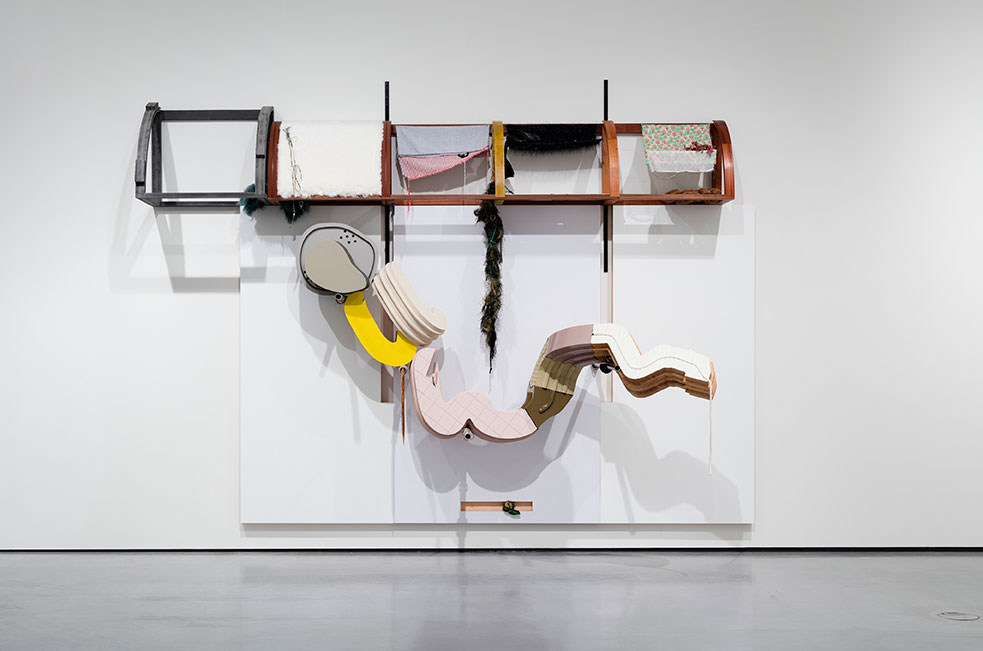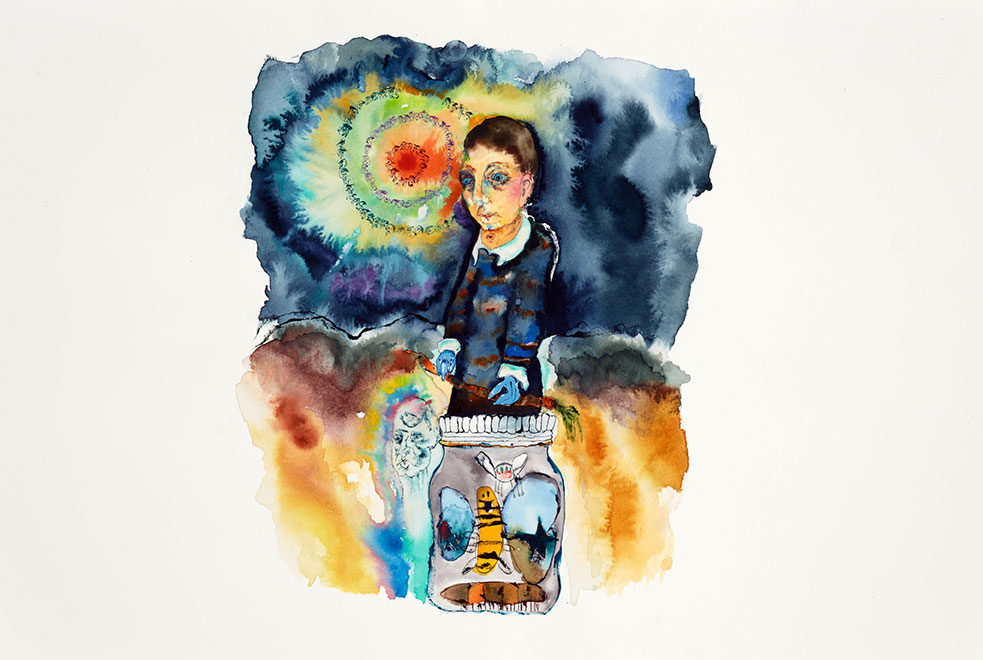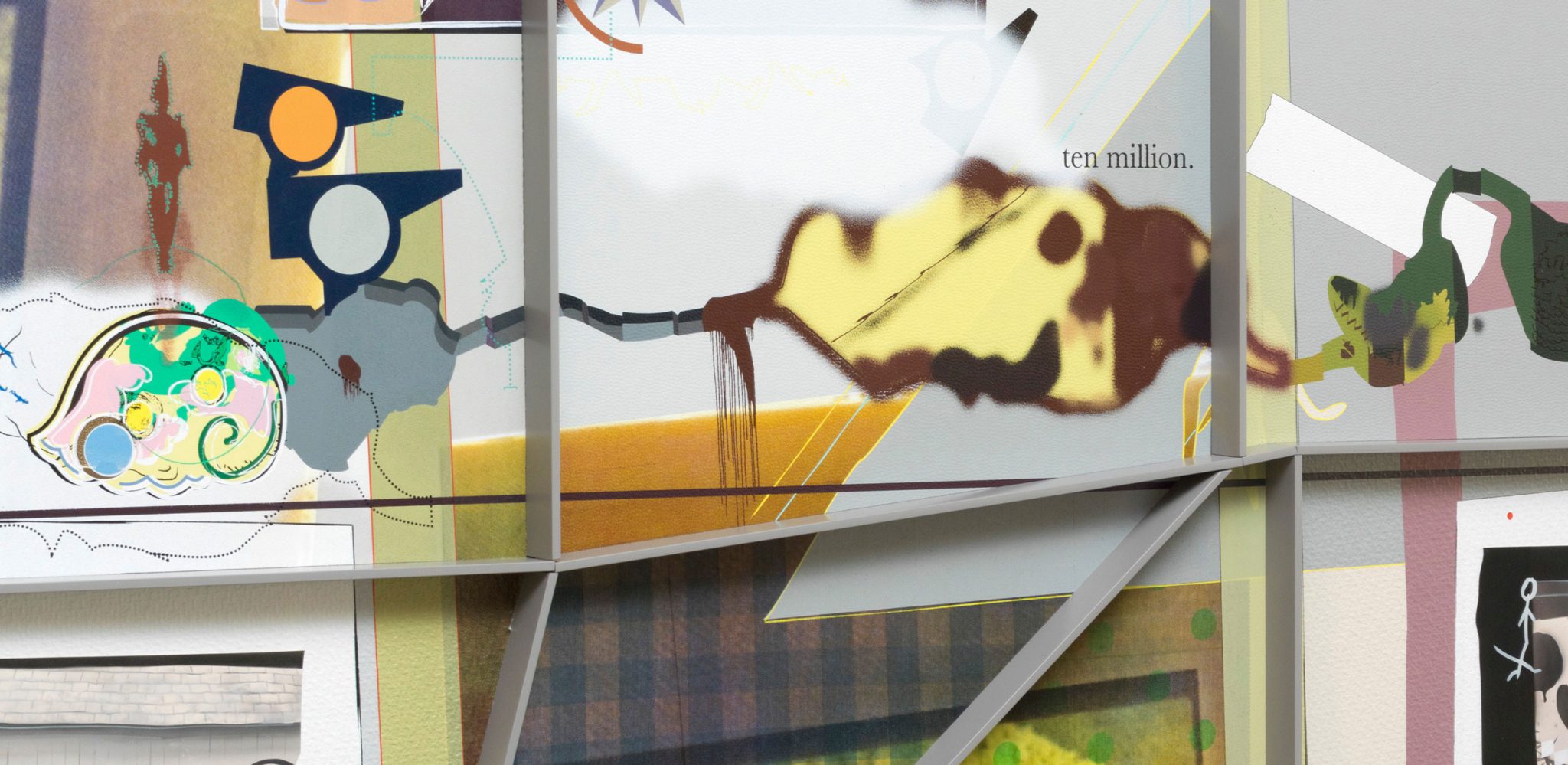The artist on taking a break from visual work to turn to writing, life changes under lockdown and her favourite audiobooks
The titles of Helen Marten’s sculptures have long suggested a literary mind at work: Puddlefoot, digging, Limpet Apology (traffic tenses), Brood and Bitter Pass (all 2015). These portmanteaus and locutionary couplings stimulate the mind’s tongue. The British artist approaches language as she does material: lining up familiar signifiers, end to end, until their meanings negate themselves. Images form, momentarily, but refuse to solidify. What remains is a series of sounds.
Marten is well known for her distinct vocabulary of objects, which oscillate between digital and handmade, sleek and unwieldy. Recently, she took a break from her visual work to write her first novel, The Boiled in Between (2020). Its form shares the multifarious aesthetic of her visuals, nesting intimate and corporeal moments within the cold chassis of some kind of reference manual. Its sentences explode the DNA of her titles into a swirling, unreal narrative, reminiscent of the Gordon Lish school of wordplay: ‘I dream of sleeping inside a hollowed-out white loaf with lots of same self, same sex, heartless passion and headless chase’. Another: ‘There were no ordinary espressos, just everything blown up big enough to keep caffeine and virtue in one breath’.
I interviewed Marten over several days of emails. Since the pandemic began, she had been away from her home in the UK and was living in Holland. In her emails, she gave small glimpses into her life there, with anecdotes about her morning walks and the animals she observed, including ‘something long and red, low to the ground, like a hairy frankfurter with legs’. By the end of our exchange, the language of her fiction, correspondence and interview had conjoined to form a unified verbal world.

Ross Simonini What kind of process did you use for writing this novel? Did it unfold in a straight line or, as the structure suggests, through a kind of collage?
Helen Marten Well, there wasn’t really a process! I took a year out of the studio, physically removed from it. Partly because I was besieged with a mouse infestation I was pathologically tormented by, partly because I’d had a relentless year with virtually no critical dialogue and I was frustrated. I needed a conceptual rearrange. The stubborn adhesive blobbing all the parts together in the work I make is often made from language, and I suppose I wanted a new, more visible relationship with it. I always write, but I’ve never fully given in to it before. Nothing I do is in a straight line! I like to find wandering concepts and beat them until something else inevitably falls out. The book was written in that strangely virtuous sitting-down-at-a-desk-all- day-every-day kind of way. Something just kind of burst, and I loved it. It was never about encountering a single empirical problem, but allowing ideas to multiply at great speed until their mutual rhymes of both image and language arrived and found me somewhere else. I would comb away at sentences, smoothing them down, and then blow them out of place again, rumple them, violate them! I always tackle writing like a plotting of a diagram – holding individual abstractions in mind together, exercising them together, adding and subtracting until there is something algorithmic at work and everything has a place. So yes, I suppose collage in a sense, but more staggering; something more like snooker – a knocking-on of things but done within an envelope of distinct logic.
RS What do you mean when you say a ‘year with virtually no critical dialogue’?
HM Well, I had worked very intensely on several large exhibitions, and rather than feeling like I’d thrashed out conversations about everything I was doing, there was just a great vacuum of silence. Of course I talk relentlessly to myself, making notes, pushing pieces around, but it was sad that, for whatever reason, the dynamic existence of these works outside my own space was so fleeting.
RS Would you call it an indifferent response? Did it affect how you feel about your work?
HM I think indifference is wrong – there was great joy and satisfaction that unfolded with making the work public, sharing it with all the different people I work with. I just wanted something more hardcore! A critical response in the sense of unstitching or shredding – something volatile and elemental like finding the basic pattern, diagramming it, naming the parts, renaming the parts, making them feel uncomfortably scrutinised, all the better to understand why they are there. Of course you do this for yourself, and I don’t really expect someone to shepherd me neatly along with congratulations and tender questioning! This year has done something similar, and the feeling is something like: now I know nothing, I can begin to learn again. Under every rock-bottom there is another infinitely long and dark descent!

Photo: Annik Wetter. © the artist. König Galerie, Berlin, London & Tokyo
RS How do you generally use language or narrative to support the visual work? At what point does language contribute to the process?
HM I love when material is enabled and then undone. Logical, graphical relationships are embedded in sculpture, because a large part of the enigma is right in front of you, visually evident. The more formal elements of colour or texture or balance are conditional, generative parts that have their own semantic grammar. Language is part of this circuitry, but more in the way that electricity enters a house – it is part of the muscular, driving engine, but its invisibility renders it a more speculative, conceptual element. Linguistic habit means we inherently understand many visual things without having to think too hard about them – they are learned or social or innate. And this is where the strange tautology of material opens up, precisely because the known qualities of it – the clayness of clay, brickness of bricks – is part of an ancient vocabulary. Suddenly the clay becomes extra clay-y and slips beyond tactile recognition; language both holds it in and emancipates it simultaneously.
It is compositional, rhythmic, like music or speech. It’s a system of translation, and the wonderful thing about literature is that this twisting around in the mouth is how a picture emerges. You invent your own imagery and propel it forward. And I love that linguistic strategies can fiddle so much with idioms and certain turns of phrase that common objects or systems of emotion are brutally anthropomorphised: self-satisfied or political milk; an empathic orange; wind that caresses, snacks, gurgles, yawns, beats about the head. You have to pay such close attention, or another wriggling metamorphic cycle happens, and there you are off-piste again…
RS Were you making any work outside of the novel during this period?
HM I made some drawings and little sketches for bigger works, but other than that I made nothing else. And it was so liberating to momentarily extinguish the problems of logistics and gravity!

RS What are your reading habits?
HM Rabid and overambitious. My book-buying vs reading-capacity ratio is sorely uneven, so I’m surrounded by pressing stacks. I listen prolifically to audiobooks when I’m doing other things, and it feels like a miracle.
RS What audiobooks in particular have you enjoyed? Any trends or patterns in your listening?
HM This is difficult… most recently: Crime and Punishment! I spent a very hot week drawing despicably hairy animals and a clogged U-bend with very soft pencils in constant need of resharpening. Boiling sun mashing my head and eyes, and that incredible story of ethical paralysis and egotism drumming in. Some penance for my sins, I’m certain. I’ve just been on a Cormac McCarthy binge. Right now Elfriede Jelinek’s Greed with some Diane Williams and Colson Whitehead alongside. Trends seem to be the dark triads of psychology: narcissism, manipulation and psychopathy! I also just love a winding story.
RS What was your writing practice like before the novel?
HM Nonfiction! I’ve always written about substance and material, about other artists’ work, about ‘concepts’. I love the long-form essay. I have two ongoing writing projects – one a grubby lexicon (rats, floor plans, shadows, blood) and another currently titled ‘collage vs inlay’. One day perhaps they’ll become something.
RS The history of novels is so weighty. I personally had some resistance to the term novel around my book but relented due to the publisher’s request. What brought you to fiction? What about the form of a novel interested you?
HM There are narratives that project a careful language for their subjects, ones that proceed colloquially even lyrically with little difficulty. And then there are narratives gleefully heavy with their own dissonance. I would much rather fall on the dissonance side, because I worry that with all writing there is an inertia that comes by trying too hard to explain. I don’t want to see too many flags hoisted that attempt to make you feel better as the reader by signalling out a more careful route through it all. I love the metaphorical struggle you might have with a gruesome text where you attempt and fail to peel away the glue keeping it all together and realise it is all over you – that image, language, all of it is stuck to you and you are part of the animation machine making it happen! How wonderful that potatoes or the current of a river might be more alive than the characters themselves. The novel can be a newly disembodied agent of narrative in so many ways – it has so many names, so many terms, so many alternating metrics of speed and storytelling that I suppose I feel unburdened by terminology. What I most love about a ‘novel’ is that it is a minute cosmos, and within that space is a loose scaffold upon which scraps of truth and imagination hang – you can choose to wallow in it, or chase it in another direction.

Photo: Robert Glowacki. © the artist. Courtesy Sadie Coles HQ, London
RS What novels have functioned this way for you?
HM A remarkable book is Ben Marcus’s The Age of Wire and String (1995). It’s a genius narrative built using a totally perverted set of technical terms for common taxonomical things: food, sleep, God, animals, society. It’s somehow like a recycled handbook that understands how our world is one where image is the meta-event. It defies physics and language but keeps its reader close because it is built precisely from things that we intimately understand. The great dark comedy of this book is that we are served, in various guises, steaming thematic lessons for existing within a democracy of space. This book realises that nature, television, the supermarket, even an estate agent’s ‘for sale’ sign offer macro templates for living.
RS For you, do language and material express different aspects of yourself? Or do you consider them translations of a similar fundamental impulse?
HM I think with both of them I have a compulsion to associate, to twist and wind things so obstinately and deliberately together that they have no choice but to become something else. As both producer and receiver, I feel like my only job is to turn on the tap and already that is a linguistically creative contribution! Perhaps you are filling, scrubbing, bathing, cleaning, rinsing, cooling – already that is so many different turns of translation for the water that is released. And then you only need to paddle a little further and suddenly you are thinking more theoretically about the greater system of economics and infrastructure to which tap-function is connected, the copper mined for plumbing, the problematic idea of even having a tap when considering the current drought in Zimbabwe or Southern Africa. And then there is the hyperbole of biblical rain. Or the surrealism of an architect suddenly explaining that there is a hidden swimming pool under your kitchen table. The translation impulse for both art and literature, for me, is very similar. And of course some things work and some don’t. Although somehow both still tell the truth, albeit against their will.
RS Fiction is often a chronicle of passing time, which isn’t so glaringly true of sculpture. How do you think about the movement of time when you write narrative?
HM Time and love share a great deal – their wide arc that is full of incomprehensibility, with horror and hallucination! Good stories deal in that, I think. If I imagine time, I’d group it also with wind and dust. They are corroborating motifs. Dust appears again and again as a gruesome object, as a material that flecks its antique glaze over everything, that coats the body – that is of the body – that pitilessly falls on all manner of material stuff and cannot be removed. Both are everything and nothing, a kind of luminous nonmatter. Time is something like a collection of little flags that mark the direction or journey of language, except in this instance the intricate patterns of behaviour and action move the narrative within a very limited space. Time really rubs your face in it when all that has been achieved is a melancholy soliloquy on self-loathing, on the odd joyousness of having nipples, or the morbidity of believing the mirror has poisoned the heart! Language protects and wounds. Time does just the same. And there are so many different kinds of time: the time of rain, the time of God, of family, of domestic content or political malaise. Time lures you in only to kick you in the mouth.
RS The book is largely concerned with architectural spaces of homes. How would you describe your home? What’s its personality? What effect does it have on you?
HM I usually live in London, but for the last four-and-a-half months I’ve been in the Netherlands. I am by the sea, so that sense of everything gaping or luring you toward the coast is always there. This is the land of big sky, of cute cumulus clouds like merry dumplings, so domestic building seems almost secondary to that – houses are fashioned to accommodate light and sky in a way that London’s carbon dankness never was. My London life literally stinks. Trains rattle, I can hear my neighbours piss or open a can. Everything in the book revolves around this metaphoric obsession with ‘the home’ – the objects of it are let loose, even abstract processes feel part of the plot. I work in bouts of fanatic tidiness and manic chaos, extremes that force me to deal with being a body in a predetermined space. I’m interested in this structural or physical violence that architecture performs on us, how it indexes or emancipates. I suppose that is the difference now, looking at my displacement: I’ve swapped a metropolitan somewhere for a verdant nowhere.

Courtesy König Galerie, Berlin, London & Tokyo
RS Do you feel that architecture is always a force of violence? Obviously, shelter is also a kind of luxury. Have you encountered buildings that manage to express antiviolence?
HM I suppose anything that toys with an inside and an outside harbours potential for violence. To be let in or shut out. Shelter, certainly, is a luxury. I suppose I mean violence as a kind of oppositional idea to protection – the moment of seeing through any camouflage and recognising a duality, that what keeps you dry and safe can also turn over and over in your mind to become something newly cold and unappealing. Something like letting the animal of language in through the back door and seeing suddenly how it renames everything! The beginning thoughts for the book were thinking of buildings as weapons or bodies, with all the same galvanic, liquid or atomic circuitry as a breathing figure.
RS In the book you mention an ‘enlightened house’. What is that?
HM Haha! Perhaps the enlightened house is a parody of the conventions of any kind of heteronorm! That is to say, an enlightened house wears its shame on the outside and takes pride in its cracks.
RS Do you have any interest in working in the field of architecture?
HM Absolutely not! I will leave that to the kinder, more carefully processed citizens!
Helen Marten’s debut novel, The Boiled in Between, was published in September by Prototype. A solo exhibition of new drawings is on view at Sadie Coles HQ, Kingly Street, London, through 17 October.
Ross Simonini is an artist and writer based in California
